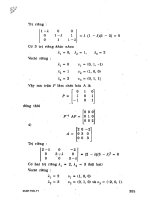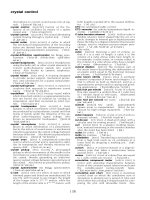Maintenance Fundamentals Episode 1 part 10 pdf
Bạn đang xem bản rút gọn của tài liệu. Xem và tải ngay bản đầy đủ của tài liệu tại đây (400.2 KB, 20 trang )
Mechanical Flexing
Mechanical-flexing couplings provide a flexible connection by permitting the
coupling components to move or slide relative to each other. To permit
such movement, clearance must be provided within specified limits. It is import-
ant to keep cross loading on the connected shafts at a minimum. This is
accomplished by providing adequate lubrication to reduce wear on the coupling
components. The most popular of the mechanical-flexing type are the chain and
gear couplings.
Chain Chain couplings provide a good means of transmitting proportionately
high torque at low speeds. Minor shaft misalignment is compensated for by
means of clearances between the chain and sprocket teeth and the clearance that
exists within the chain itself.
Figure 10.2 Typical split rigid coupling.
Keith Mobley /Maintenance Fundamentals Final Proof 15.6.2004 7:35pm page 174
174 Maintenance Fundamentals
The design consists of two hubs with sprocket teeth connected by a chain of the
single-roller, double-roller, or silent type. A typical example of a chain coupling
is illustrated in Figure 10.4.
Special-purpose components may be specified when enhanced flexibility and
reduced wear are required. Hardened sprocket teeth, special tooth design, and
barrel-shaped rollers are available for special needs. Light-duty drives are some-
times supplied with non-metallic chains on which no lubrication should be used.
Gear Gear couplings are capable of transmitting proportionately high torque at
both high and low speeds. The most common type of gear coupling consists of
two identical hubs with external gear teeth and a sleeve, or cover, with matching
internal gear teeth. Torque is transmitted through the gear teeth, whereas the
necessary sliding action and ability for slight adjustments in position comes from
a certain freedom of action provided between the two sets of teeth.
Slight shaft misalignment is compensated for by the clearance between the
matching gear teeth. However, any degree of misalignment decreases the useful
life of the coupling and may cause damage to other machine-train components
such as bearings. A typical example of a gear-tooth coupling is illustrated in
Figure 10.5.
Figure 10.3 Typical compression rigid coupling.
Keith Mobley /Maintenance Fundamentals Final Proof 15.6.2004 7:35pm page 175
Couplings 175
Material Flexing
Material-flexing couplings incorporate elements that accommodate a certain
amount of bending or flexing. The material-flexing group includes laminated
disk-ring, bellows, flexible shaft, diaphragm, and elastomeric couplings.
Various materials such as metal, plastic, or rubber are used to make the flexing
elements in these couplings. The use of the couplings is governed by the oper-
ational fatigue limits of these materials. Practically all metals have fatigue limits
that are predictable; therefore, they permit definite boundaries of operation to be
established. Elastomers such as plastic or rubber, however, usually do not have a
well-defined fatigue limit. Their service life is determined primarily by conditions
of installation and operation.
Roller-chain Coupling
Coupling Cover (½ Shown)
(Optional)
Roller Chain
1 Required to
Join Couplers
Coupling Body(s)
1 Required for Each Shaft
Figure 10.4 Typical chain coupling.
Keith Mobley /Maintenance Fundamentals Final Proof 15.6.2004 7:35pm page 176
176 Maintenance Fundamentals
Laminated Disk-Ring The laminated disk-ring coupling consists of shaft hubs
connected to a single flexible disk, or a series of disks, that allows axial move-
ment. The laminated disk-ring coupling also reduces heat and axial vibration
that can transmit between the driver and driven unit. Figure 10.6 illustrates some
typical laminated disk-ring couplings.
Bellows Bellows couplings consist of two shaft hubs connected to a flexible
bellows. This design, which compensates for minor misalignment, is used at
moderate rotational torque and shaft speed. This type of coupling provides
flexibility to compensate for axial movement and misalignment caused by ther-
mal expansion of the equipment components. Figure 10.7 illustrates a typical
bellows coupling.
Flexible Shaft or Spring Flexible shaft or spring couplings are generally used in
small equipment applications that do not experience high torque loads. Figure
10.8 illustrates a typical flexible shaft coupling.
Diaphragm Diaphragm couplings provide torsional stiffness while allowing
flexibility in axial movement. Typical construction consists of shaft hub flanges
Figure 10.5 Typical gear-tooth coupling.
Keith Mobley /Maintenance Fundamentals Final Proof 15.6.2004 7:35pm page 177
Couplings 177
Figure 10.6 Typical laminated disk-ring couplings.
Figure 10.7 Typical bellows coupling.
Keith Mobley /Maintenance Fundamentals Final Proof 15.6.2004 7:35pm page 178
178 Maintenance Fundamentals
and a diaphragm spool, which provides the connection between the driver and
driven unit. The diaphragm spool normally consists of a center shaft fastened to
the inner diameter of a diaphragm on each end of the spool shaft. The shaft hub
flanges are fastened to the outer diameter of the diaphragms to complete the
mechanical connection. A typical diaphragm coupling is illustrated in Figure 10.9.
Elastomeric Elastomeric couplings consist of two hubs connected by an elasto-
meric element. The couplings fall into two basic categories, one with the element
placed in shear and the other with its element placed in compression. The
coupling compensates for minor misalignments because of the flexing capability
Figure 10.8 Typical flexible shaft coupling.
Figure 10.9 Typical diaphragm coupling.
Keith Mobley /Maintenance Fundamentals Final Proof 15.6.2004 7:35pm page 179
Couplings 179
of the elastomer. These couplings are usually applied in light- or medium-duty
applications running at moderate speeds.
With the shear-type coupling, the elastomeric element may be clamped or bonded
in place, or fitted securely to the hubs. The compression-type couplings may be
fitted with projecting pins, bolts, or lugs to connect the components. Polyurethane,
rubber, neoprene, or cloth and fiber materials are used in the manufacture of these
elements.
Although elastomeric couplings are practically maintenance free, it is good
practice to periodically inspect the condition of the elastomer and the alignment
of the equipment. If the element shows signs of defects or wear, it should be
replaced and the equipment realigned to the manufacturer’s specifications. Typ-
ical elastomeric couplings are illustrated in Figure 10.10.
Combination (Metallic-Grid)
The metallic-grid coupling is an example of a combination of mechanical-flexing
and material-flexing type couplings. Typical metallic-grid couplings are illus-
trated in Figure 10.11.
The metallic-grid coupling is a compact unit capable of transmitting high torque at
moderate speeds. The construction of the coupling consists of two flanged hubs,
each with specially grooved slots cut axially on the outer edges of the hub flanges.
The flanges are connected by means of a serpentine-shaped spring grid that fits
into the grooved slots. The flexibility of this grid provides torsional resilience.
Special Application Couplings
Two special application couplings are discussed in this section: (1) the floating-
shaft or spacer coupling and (2) the hydraulic or fluid coupling.
Floating-Shaft or Spacer Coupling
Regular flexible couplings connect the driver and driven shafts with relatively close
ends and are suitable for limited misalignment. However, allowances sometimes
have to be made to accommodate greater misalignment or when the ends of the
driver and driven shafts have to be separated by a considerable distance.
Such is the case, for example, with end-suction pump designs in which the power
unit of the pump assembly is removed for maintenance by being axially moved
toward the driver. If neither the pump nor the driver can be readily removed, they
should be separated sufficiently to permit withdrawal of the pump’s power unit.
An easily removable flexible coupling of sufficient length (i.e., floating-shaft or
Keith Mobley /Maintenance Fundamentals Final Proof 15.6.2004 7:35pm page 180
180 Maintenance Fundamentals
spacer coupling) is required for this type of maintenance. Examples of couplings
for this type of application are shown in Figure 10.12.
In addition to the maintenance application described above, this coupling (also
referred to as extension or spacer sleeve coupling) is commonly used where
equipment is subject to thermal expansion and possible misalignment because
of high process temperatures. The purpose of this type of coupling is to prevent
harmful misalignment with minimum separation of the driver and driven shaft
ends. An example of a typical floating-shaft coupling for this application is
shown in Figure 10.13.
Figure 10.10 Typical elastomeric couplings.
Keith Mobley /Maintenance Fundamentals Final Proof 15.6.2004 7:35pm page 181
Couplings 181
The floating-shaft coupling consists of two support elements connected by a shaft.
Manufacturers use various approaches in their designs for these couplings. For
example, each of the two support elements may be of the single-engagement
type, may consist of a flexible half-coupling on one end and a rigid half-coupling
on the other end, or may be completely flexible with some piloting or guiding
supports.
Floating-shaft gear couplings usually consist of a standard coupling with a two-
piece sleeve. The sleeve halves are bolted to rigid flanges to form two single-flex
Figure 10.11 Typical metallic-grid couplings.
Figure 10.12 Typical floating-shaft or spacer couplings.
Keith Mobley /Maintenance Fundamentals Final Proof 15.6.2004 7:35pm page 182
182 Maintenance Fundamentals
couplings. An intermediate shaft, which permits the transmission of power be-
tween widely separated drive components, connects these.
Hydraulic or Fluid
Hydraulic couplings provide a soft start with gradual acceleration and limited
maximum torque for fixed operating speeds. Hydraulic couplings are typically
used in applications that undergo torsional shock from sudden changes in
equipment loads (e.g., compressors). Figure 10.14 is an illustration of a typical
hydraulic coupling.
COUPLING SELECTION
Periodically, worn or broken couplings must be replaced. One of the most
important steps in performing this maintenance procedure is to ensure that the
correct replacement parts are used. After having determined the cause of failure,
it is crucial to identify the correct type and size of coupling needed. Even if
Figure 10.13 Typical floating-shaft or spacer couplings for high-temperature applica-
tions.
Keith Mobley /Maintenance Fundamentals Final Proof 15.6.2004 7:35pm page 183
Couplings 183
practically identical in appearance to the original, a part still may not be an
adequate replacement.
The manufacturer’s specification number usually provides the information
needed for part selection. If the part is not in stock, a cross-reference guide will
provide the information needed to verify ratings and to identify a coupling that
meets the same requirements as the original.
Criteria that must be considered in part selection include equipment type,
mode of operation, and cost. Each of these criteria is discussed in the sections
to follow.
Equipment Type
Coupling selection should be application specific, and therefore it is important to
consider the type of equipment that it connects. For example, demanding appli-
cations such as variable, high-torque machine-trains require couplings that are
specifically designed to absorb radical changes in speed and torque (e.g., metal-
lic-grid). Less demanding applications such as run-out table rolls can generally
get by with elastomeric couplings. Table 10.1 lists the coupling type commonly
used in a particular application.
Mode of Operation
Coupling selection is highly dependent on the mode of operation, which includes
torsional characteristics, speed, and the operating envelope.
Figure 10.14 Typical hydraulic coupling.
Keith Mobley /Maintenance Fundamentals Final Proof 15.6.2004 7:35pm page 184
184 Maintenance Fundamentals
Table 10.1 Coupling Application Overview
Application Coupling* Selection Recommendation
Limited Misalignment Compensation
Variable, high-torque machine-trains
operating at moderate speeds
Metallic-grid combination couplings
Run-out table rolls Elastomeric flexible couplings
Vertical pump shafting Flanged rigid couplings, split rigid or
clamp couplings
Keys and keyways not appropriate (e.g.,
brass shafts)
Rigid compression couplings
Transmission of proportionately high
torque at low speeds
Chain couplings (mechanical-flexing)
Transmission of proportionately high
torque at both high and low speeds
Gear couplings (mechanical-flexing)
Allowance for axial movement and
reduction of heat and axial vibration
Laminated disk-ring couplings (material-
flexing)
Moderate rotational torque and shaft
speed
Bellows couplings (material-flexing)
Small equipment that does not experience
high torque loads
Flexible shaft or spring couplings
(material-flexing)
Torsional stiffness while allowing flexibility
in axial movement
Diaphragm material-flexing couplings
Light- or medium-duty applications
running at moderate speeds
Elastomeric couplings (material-flexing)
Gradual acceleration and limited
maximum torque for fixed operating
speeds (e.g., compressors).
Hydraulic or fluid couplings
Variable or high torque and/or speed
transmission
Flexible couplings rated for the maximum
torque requirement
(continues)
Keith Mobley /Maintenance Fundamentals Final Proof 15.6.2004 7:35pm page 185
Couplings 185
Table 10.1 (continued)
Application Coupling* Selection Recommendation
Greater Misalignment Compensation
Maintenance requiring considerable
distance between the driver and driven
shaft ends
Floating-shaft or spacer couplings
Misalignment results from expansion due
to high process temperatures
*See Table 10.6 for an application overview for clutches.
Note: Rigid couplings are not designed to absorb variations in torque and speed and should not be
used in such applications. Maximum in-service coupling speed should be at least 15% below the
maximum coupling speed rating.
Torsional Characteristics
Torque requirements are a primary concern during the selection process. In all
applications in which variable or high torque is transmitted from the driver to
the driven unit, a flexible coupling rated for the maximum torque requirement
must be used. Rigid couplings are not designed to absorb variations in torque
and should not be used.
Speed
Two speed-related factors should be considered as part of the selection process:
maximum speed and speed variation.
Maximum Speed When selecting coupling type and size, the maximum speed
rating must be considered, which can be determined from the vendor’s catalog.
The maximum in-service speed of a coupling should be well below (at least 15%)
the maximum speed rating. The 15% margin provides a service factor that should
be sufficient to prevent coupling damage or catastrophic failure.
Speed Variation Variation in speed equates to a corresponding variation in
torque. Most variable-speed applications require some type of flexible coupling
capable of absorbing these torsional variations.
Operating Envelope
The operating envelope defines the physical requirements, dimensions, and type
of coupling needed in a specific application. The envelope information should
include shaft sizes, orientation of shafts, required horsepower, full range of
operating torque, speed ramp rates, and any other data that would directly or
indirectly affect the coupling.
Keith Mobley /Maintenance Fundamentals Final Proof 15.6.2004 7:35pm page 186
186 Maintenance Fundamentals
Cost
Coupling cost should not be the deciding factor in the selection process, although
it will certainly play a part in it. Although higher-performance couplings may be
more expensive, they actually may be the cost-effective solution in a particular
application. Selecting the most appropriate coupling for an application not only
extends coupling life but also improves the overall performance of the machine-
train and its reliability.
INSTALLATION
Couplings must be installed properly if they are to operate satisfactorily. This
section discusses shaft and coupling preparation, coupling installation, and
alignment.
Shaft Preparation
A careful inspection of both shaft ends must be made to ensure that no burrs,
nicks, or scratches are present that will damage the hubs. Potentially damaging
conditions must be corrected before coupling installation. Emery cloth should be
used to remove any burrs, scratches, or oxidation that may be present. A light
film of oil should be applied to the shafts prior to installation.
Keys and keyways also should be checked for similar defects and to ensure that
the keys fit properly. Properly sized key stock must be used with all keyways; do
not use bar stock or other material.
Coupling Preparation
The coupling must be disassembled and inspected prior to installation. The
location and position of each component should be noted so that it can be
reinstalled in the correct order. When old couplings are removed for inspection,
bolts and bolt holes should be numbered so that they can be installed in the same
location when the coupling is returned to service.
Any defects, such as burrs, should be corrected before the coupling is installed.
Defects on the mating parts of the coupling can cause interference between the
bore and shaft, preventing proper operation of the coupling.
Coupling Installation
Once the inspection shows the coupling parts to be free of defects, the hubs can
be mounted on their respective shafts. If it is necessary to heat the hubs to
achieve the proper interference fit, an oil or water bath should be used. Spot
Keith Mobley /Maintenance Fundamentals Final Proof 15.6.2004 7:35pm page 187
Couplings 187
heating with a flame or torch should be avoided because it causes distortion and
may adversely affect the hubs.
Care must be exercised during installation of a new coupling or the reassembly of
an existing unit. Keys and keyways should be coated with a sealing compound that
is resistant to the lubricant used in the coupling. Seals should be inspected to ensure
that they are pliable and in good condition. They must be installed properly in the
sleeve with the lip in good contact with the hub. Sleeve flange gaskets must be
whole, in good condition, clean, and free of nicks or cracks. Lubrication plugs
must be cleaned before being installed and must fit tightly.
The specific installation procedure is dependent on the type and mounting
configuration of the coupling. However, common elements of all coupling instal-
lations include: spacing, bolting, lubrication, and the use of matching parts. The
sections to follow discuss these installation elements.
Spacing
Spacing between the mating parts of the coupling must be within manufacturer’s
tolerances. For example, an elastomeric coupling must have a specific distance
between the coupling faces. This distance determines the position of the rubber
boot that provides transmission of power from the driver to the driven machine
component. If this distance is not exact, the elastomer will attempt to return to
its relaxed position, inducing excessive axial movement in both shafts.
Bolting
Couplings are designed to use a specific type of bolt. Coupling bolts have a
hardened cylindrical body sized to match the assembled coupling width. Hardened
bolts are required because standard bolts do not have the tensile strength to absorb
the torsional and shearing loads in coupling applications and may fail, resulting in
coupling failure and machine-train damage.
Lubrication
Most couplings require lubrication, and care must be taken to ensure that the
proper type and quantity is used during the installation process. Inadequate or
improper lubrication reduces coupling reliability and reduces its useful life. In
addition, improper lubrication can cause serious damage to the machine-train.
For example, when a gear-type coupling is over filled with grease, the coupling
will lock. In most cases, its locked position will increase the vibration level and
induce an abnormal loading on the bearings of both the driver and driven unit,
resulting in bearing failure.
Keith Mobley /Maintenance Fundamentals Final Proof 15.6.2004 7:35pm page 188
188 Maintenance Fundamentals
Matching Parts
Couplings are designed for a specific range of applications, and proper perform-
ance depends on the total design of the coupling system. As a result, it is
generally not a good practice to mix coupling types. Note, however, that it is
common practice in some steel industry applications to use coupling halves from
two different types of couplings. For example, a rigid coupling half is sometimes
mated to a flexible coupling half, creating a hybrid. While this approach may
provide short-term power transmission, it can result in an increase in the
number, frequency, and severity of machine-train problems.
Coupling Alignment
The last step in the installation process is verifying coupling and shaft alignment.
With the exception of special application couplings such as spindles and
jackshafts, all couplings must be aligned within relatively close tolerances (i.e.,
0.001–0.002 in.).
LUBRICATION AND MAINTENANCE
Couplings require regular lubrication and maintenance to ensure optimum
trouble-free service life. When proper maintenance is not conducted, premature
coupling failure and/or damage to machine-train components such as bearings
can be expected.
Determining Cause of Failure
When a coupling failure occurs, it is important to determine the cause of failure.
Failure may result from a coupling defect, an external condition, or workman-
ship during installation.
Most faults are attributed to poorly machined surfaces causing out-of-
specification tolerances, although defective material failures also occur.
Inadequate material hardness and poor strength factors contribute to many pre-
mature failures. Other common causes are improper coupling selection, improper
installation, and/or excessive misalignment.
Lubrication Requirements
Lubrication requirements vary depending on application and coupling type.
Because rigid couplings do not require lubrication, this section discusses lubrica-
tion requirements for mechanical-flexing, material-flexing, and combination
flexible couplings only.
Keith Mobley /Maintenance Fundamentals Final Proof 15.6.2004 7:35pm page 189
Couplings 189
Mechanical-Flexing Couplings
It is important to follow the manufacturer’s instructions for lubricating mechan-
ical-flexing couplings, which must be lubricated internally. Lubricant seals must
be in good condition and properly fitted into place. Coupling covers contain
the lubricant and prevent contaminants from entering the coupling interior. The
covers are designed in two configurations, split either horizontally or vertically.
Holes are provided in the covers to allow lubricant to be added without coupling
disassembly.
Gear couplings are one type of mechanical-flexing coupling, and there are several
ways to lubricate them: grease pack, oil fill, oil collect, and continuous oil flow.
Either grease or oil can be used at speeds of 3,600 rpm to 6,000 rpm. Oil is
normally used as the lubricant in couplings operating over 6,000 rpm. Grease
and oil-lubricated units have end gaskets and seals, which are used to contain the
lubricant and seal out the entry of contaminants. The sleeves have lubrication
holes, which permit flushing and re-lubrication without disturbing the sleeve
gasket or seals.
Material-Flexing Couplings
Material-flexing couplings are designed to be lubrication free.
Combination Couplings
Combination (metallic-grid) couplings are lubricated in the same manner as
mechanical-flexing couplings.
Periodic Inspections
It is important to perform periodic inspections of all mechanical equipment and
systems that incorporate rotating parts, including couplings and clutches.
Mechanical-Flexing Couplings
To maintain coupling reliability, mechanical-flexing couplings require periodic
inspections on a time- or condition-based frequency established by the history of
the equipment’s coupling life or a schedule established by the predictive main-
tenance engineer. Items to be included in an inspection are listed below. If any of
these items or conditions is discovered, the coupling should be evaluated to
determine its remaining operational life or be repaired/replaced.
Inspect lubricant for traces of metal (indicating component wear).
Visually inspect coupling mechanical components (roller chains and
gear teeth, and grid members) for wear and/or fatigue.
Keith Mobley /Maintenance Fundamentals Final Proof 15.6.2004 7:35pm page 190
190 Maintenance Fundamentals
Inspect seals to ensure they are pliable and in good condition. They
must be installed properly in the sleeve with the lip in good contact
with the hub.
Sleeve flange gaskets must be whole, in good condition, clean, and free
of nicks or cracks.
Lubrication plugs must be clean (to prevent the introduction of con-
taminants to the lubricant and machine surfaces) before being installed
and must be torqued to the manufacturer’s specifications.
Setscrews and retainers must be in place and tightened to manu-
facturer’s specifications.
Inspect shaft hubs, keyways, and keys for cracks, breaks, and physical
damage.
Under operating conditions, perform thermographic scans to deter-
mine temperature differences on the coupling (indicates misalignment
and/or uneven mechanical forces).
Material-Flexing Couplings
Although designed to be lubrication-free, material-flexing couplings also require
periodic inspection and maintenance. This is necessary to ensure that the
coupling components are within acceptable specification limits. Periodic inspec-
tions for the following conditions are required to maintain coupling reliability. If
any of these conditions are found, the coupling should be evaluated to determine
its remaining operational life or be repaired/replaced.
Inspect flexing element for signs of wear or fatigue (cracks, element
dust or particles).
Setscrews and retainers must be in place and tightened to manufactur-
er’s specifications.
Inspect shaft hubs, keyways, and keys for cracks, breaks, and physical
damage.
Under operating conditions, perform thermographic scans for tempera-
ture differences on the coupling, which indicates misalignment and/or
uneven mechanical forces.
Combination Couplings
Mechanical components (e.g., grid members) should be visually inspected for
wear and/or fatigue. In addition to the items for mechanical-flexing couplings
presented in Chapter 2, the grid members on metallic-grid couplings should be
replaced if any signs of wear are observed.
Keith Mobley /Maintenance Fundamentals Final Proof 15.6.2004 7:35pm page 191
Couplings 191
Rigid Couplings
The mechanical components of rigid couplings (e.g., hubs, bolts, compression
sleeves and halves, keyways, and keys) should be visually inspected for cracks,
breaks, physical damage, wear, and/or fatigue. Any component having any of
these conditions should be replaced.
KEYS,KEYWAYS, AND KEY SEATS
A key is a piece of material, usually metal, placed in machined slots or grooves
cut into two axially oriented parts to mechanically lock them together. For
example, keys are used in making the coupling connection between the shaft of
a driver and a hub or flange on that shaft. Any rotating element whose shaft
incorporates such a keyed connection is referred to as a keyed-shaft rotor. Keys
provide a positive means for transmitting torque between the shaft and coupling
hub when a key is properly fitted in the axial groove.
The groove into which a key is fitted is referred to as a key seat when referring to
shafts and a keyway when referring to hubs. Key seating is the actual machine
operation of producing key seats. Keyways are normally made on a key eater or
by a broach. Key seats are normally made with a rotary or end mill cutter.
Figure 10.15 is an example of a keyed shaft that shows the key size versus the
shaft diameter. Because of standardization and interchangeability, keys are
generally proportioned with relation to shaft diameter instead of torsional load.
The effective key length, ‘‘L’’ is that portion of the key having full bearing on
hub and shaft. Note that the curved portion of the key seat made with a rotary
cutter does not provide full key bearing, so ‘‘L’’ does not include this distance.
The use of an end mill cutter results in a square-ended key seat.
Top View
Top View
L
Rotary
Cutter
End Mill
Cutter
L
Figure 10.15 Keyed shaft. Key size versus shaft diameter.
Keith Mobley /Maintenance Fundamentals Final Proof 15.6.2004 7:35pm page 192
192 Maintenance Fundamentals
Figure 10.16 shows various key shapes: square ends, one square end and one round
end, rounded ends, plain taper, and gibe head taper. The majority of keys are
square in cross-section, which are preferred through 4-
1
⁄
2
-in. diameter shafts. For
bores over 4-
1
⁄
2
in. and thin wall section of hubs, the rectangular (flat) key is used.
The ends are either square, rounded or gibe-head. The gibe-head is usually used
with taper keys. If special considerations dictate the use of a keyway in the hub
shallower than the preferred square key, it is recommended that the standard
rectangular (flat) key be used.
Hub bores are usually straight, although for some special applications, taper bores
are sometimes specified. For smaller diameters, bores are designed for clearance
fits, and a setscrew is used over the key. The major advantage of a clearance fit is
that hubs can be easily assembled and disassembled. For larger diameters, the
bores are designed for interference fits without setscrews. For rapid-reversing
applications, interference fits are required.
The sections to follow discuss determining keyway depth and width, keyway
manufacturing tolerances, key stress calculations, and shaft stress calculations.
DETERMINING KEYWAY DEPTH AND WIDTH
The formula given below and Figure 10.17, Table 10.1 (square keys), and Table
10.2 (flat keys) illustrate how the depth and width of standard square and flat
keys and keyways for shafts and hubs are determined.
TOP VIEWS
Square Ends
Square and Round
Rounded Ends Gibe Head Taper
Plain Taper
SIDE VIEWS
Figure 10.16 Key shapes.
Keith Mobley /Maintenance Fundamentals Final Proof 15.6.2004 7:35pm page 193
Couplings 193









